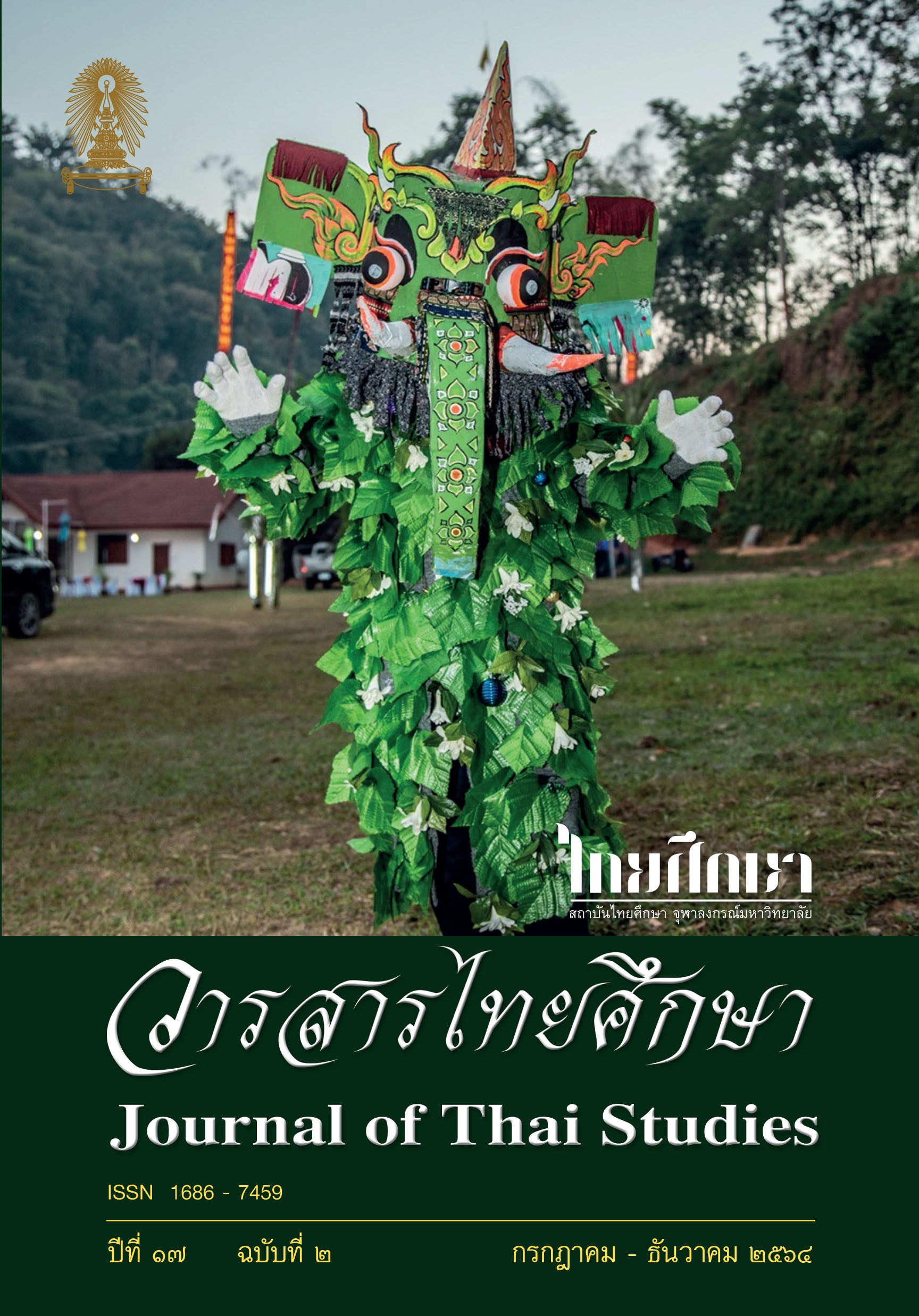The Role of Creator and Transmitter of Lanna Intellectual Cultural Heritage by Her Highness Princess Dara Rasmi
Main Article Content
Abstract
The purpose of the research for this article was to study the role of Her Highness Princess Dara Rasmi as the creator and the transmitter of Lanna intellectual cultural heritage. This study was documentary research. The method of data collection was to review primary and secondary sources, after which the data were analyzed using content analysis. The research found that Her Highness Princess Dara Rasmi played a role in creating and preserving creative Lanna culture, as well as, transmitting Lanna traditional knowledge and culture, which is the core of the process of the concept of intangible cultural heritage transmission. The role of Her Highness Princess Dara Rasmi can be divided into three areas: 1) music, song, drama and dance; 2) literature; and 3) local history.
Downloads
Article Details

This work is licensed under a Creative Commons Attribution-NonCommercial-NoDerivatives 4.0 International License.
Journal of Thai studies is licensed under a Creative Commons Attribution-Noncommercial-NoDerivatives4.0 Intenational (CC BY-NC-ND 4.0) licence, unless otherwise stated. Plese read our Policies page for more information on Open Access, copyright and permissions.
References
Aeusriwongse, N. (2012). Pakkai lae bairua waduay karnsukka phrawattisatwannakam ton Rattanakosin (Pen and Sail: Literature and History in Early Bangkok). Nonthaburi: Fa diaokan.
Atthapan, U. (1981).The Revision of Chronicles During the Reign King Rama I. (Master Thesis). Silapakon University, Bangkok, Thailand.
Bass, B. M. (1990). From Transactional to Transformational Leadership: Learning to Share the Vision. Organizational Dynamics 18(3), 19-31. Retrieved from http://dx.doi.org/10.1016/0090-2616(90)90061-S
Buranavitayawut, K. (2018). Noi Chaiya / Selemao” -an East-meets-West jazz atmosphere interpretation by the Pomelo Town Jazz Ensemble. Veridian E-Journal, Silpakorn University (Humanities, Social Sciences and arts). 1(3), 1492-1507.
Chiang Mai Provincial Cultural Council. (2001). Chjao nai fai nau kab ngan wat tana tam (Lanna Royal and Cultural Event). Chiang Mai: S.Sap Printing.
Damrong Rajanupab, H.R.H (1927). athibai rayathang long lamnam phing tangtae mueang chiang mai honthueng paknam pho (Describing traveling downstream the Ping River From Chiang Mai to Pak Nam Pho) Phra Nakhon: Sophon phi phat thana korachut Printing House.
Dissakul, P, H.S.H (2001). sing thi khaphachao phop hen prawattisat plian plaeng kan pokkhrong 2475 (What I saw in the historical change of rule in 1932). Bangkok: Matichon Press.
Hansen, S. and Van Fleet, J. (2003). Traditional Knowledge and Intellectual Property: A Handbook on Issues and Options for Traditional Knowledge Holders in Protecting their Intellectual Property and Maintaining Biological Diversity. Washington, DC: American Association for the Advancement of Science. Retrieved from https://community-wealth.org/sites/clone.community-wealth.org/files/downloads/book-hansen-vanFleet.pdf
Kaewkiriya, R., M.R. (2010). dara ratsami saiyai rak song phaendin (Dara Rasmi: The Bond of Love for Two Kingdoms). Bangkok: Chulalongkorn University Press.
Kanjanajari. N. (1990). dara ratsami : phra prawat phra rat chaya chao dara ratsami (Dara Rasmi : A Biography). Chiang Mai: Suriwong Book Centre.
Khrouthongkhieo, N. (2017). poet phaen yuet lanna (Open plan to seize Lanna). Bangkok: Matichon Press.
Khumraksa, S. (2000). dontri lae kan lalen phuenban (Folk music and play). Bangkok: Sarakhadi.
Na Chiang Mai, S. (1974). phra prawat phra rat chaya chao dara ratsami (A Biography of Dara Rasmi). Chiang Mai: Klang Wiang Printing House.
Na Chiang Mai, W. (2004). Khat ti yani sri landa (Lanna Rayal Women). Chiang Mai: Within Design.
Nimmanhaemin, P. (1974). chak uprakon rueang madam bat toe flai khong put chi ni thueng lakhon so lanna rueang noichai ya (From Puccini’s opera, Madame Butterfly, to the Slo Lanna Drama Noichaiya Story) in laksana wannakam phaknuea. Bangkok: Krung Sayam Kan Phim.
Office of the National Culture Commission. (2009). moradok phumpanya thang watthanatham (Intellectual Cultural Heritage). Bangkok: Ministry of Culture.
Pramoj, K, M.R. (1963). si phaendin (Four Reigns). Bangkok: Phrae Phitthaya.
Phakdeepumin, C. (1992). lo wang lem song (Around the palace, Volume 2). Bangkok: Chokchai Thewet.
Ratana, P. (2020). A study of the “Characteristics” of Lanna Women According to Concept of Character Education. Suan Sunandha Academic & Research Review. 14(2), 1-15.
Ratana, P. (2000). Image of “Northern Women” from late 25th to early 26th centuries (B.E.). (Master Thesis). Chiang Mai University. Thailand.
Sujachaya, S. (2013). The successor is the holder, not the owner of the cultural heritage. Journal of Thai Studies. 8, (2) : 97-121.
Suwanapichon, R. (2016). chao dara ratsami phra si ming mueang chiang mai (Princess Dara Rasmi: The Glory of Chiang Mai). Bangkok: Ban Mongkol.
Tantikun, N. (2005). lanna nai miti kanwela. (Lanna In Time Dimension). Bangkok: The Knowledge Center.
UNESCO. (2005). The Convention on the Protection and Promotion of the Diversity of Cultural Expressions. Retrieved from https://en.unesco.org/creativity/sites/creativity/files/convention2005_basictext_en.pdf
Whitaker, M.B. (2016). Cultural Transmission. Encyclopedia of Evolutionary Psychological Science. Retrieved from https://www.researchgate.net/publication/312868724_Cultural_Transmission
Yannalangka, Phrakhru.(1972). chotmaihet mueang chiang mai (Chronicles of Chiang Mai) in Chotisukarat, S (ed.) prachum tamnan lanna thai (Lanna Thai legends). Phra Nakhon: Odiansato.


